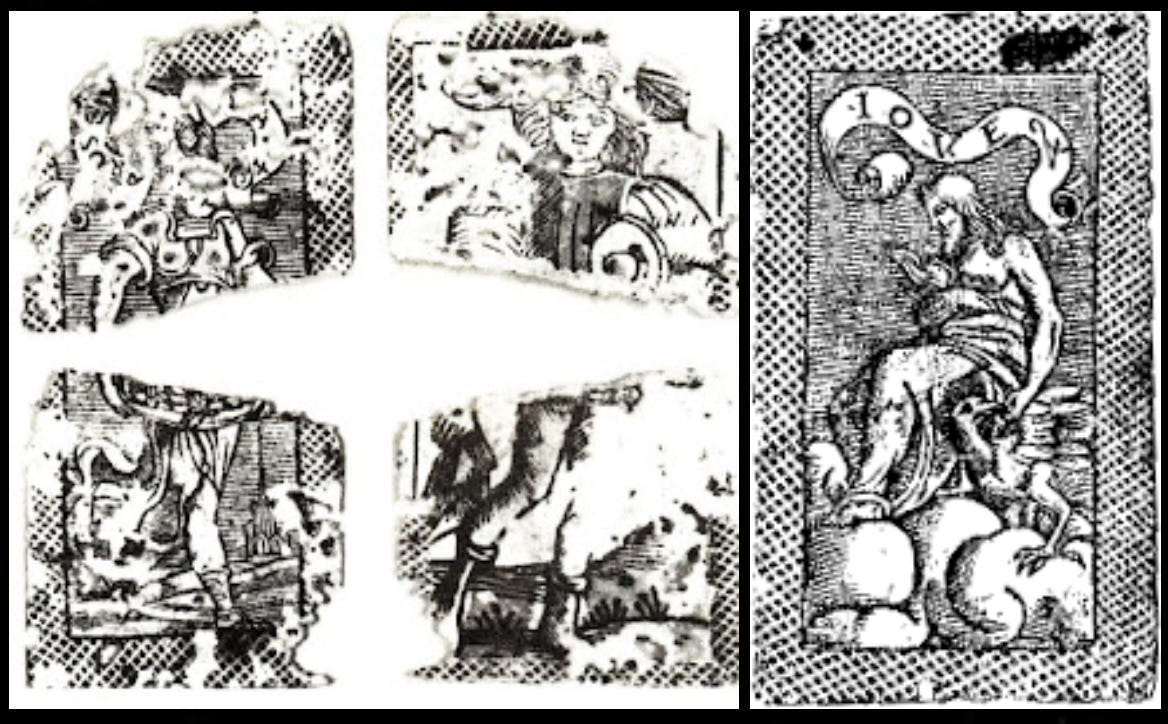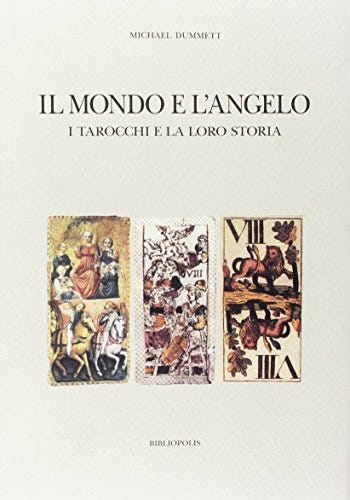Addendum to "The Oldest Tarot Cards & Where to Find Them"
This is an update to my post “The Oldest Tarot Cards & Where to Find Them”
First up, among the many collections on display as part of the Tarot: Origins & Afterlives exhibit at the Warburg Institute in London (spring 2025) there were 2 that contained cards from the XV century.1
Tarocchi di Bartolomeo Colleoni
2 cards from a private collection in the Visconti-Sforza style: a 5 of swords nearly identical to one in the Tozzi collection and a Star similar to the one at the V&A Museum. There is also a 4 of Swords in this collection that was supposed to be displayed instead of the 5, I am not sure if there are any more cards besides that.
I am also unsure of the card’s exact measurements however they do not seem to fit in with any of the other packs from the previous post. Assuming that is true and they are not a match for any other known packs, the lower estimate of remaining Visconti-Sforza cards could be updated to 238 Cards from 14 Packs.
Sforza Castle Well Cards
Also exhibited at the Warburg Institute were some of the cards and fragments from the different packs that were discovered at Sforza Castle during renovations in the early 1900’s. This one is a bit of an honorable mention as only card from this collection is from the XV century and as it is a numeral card there’s no real reason to believe that it’s even from a tarot deck.2
Among the other packs discovered at the same time was one featuring a World card similar to early Tarot de Marseille patterns. The card back depicts a scene from Orlando Furioso, dating this pack to sometime after the first edition of Ariosto’s epic was first printed in 1516. In addition to the World, six other cards from this pack survive: the 6, 7, and 9 of Swords, the 8 of Batons, and the 6 of Coins.3
5 fragments remain from a pack similar to other early 16th century decks made in Lyon. 2 fragments are badly damaged, the other 3 are a Queen of spades, an unidentifiable King with the inscription “C.C.” and a King of Diamonds.4
Then there are the well cards and fragments which have been dated anywhere between 1650 and post 1700.5 These cards also have multiple different card backs which makes it even more confusing.
“This deck, measuring approximately 69 × 102 mm, could be called the Deck of the Gods of Olympus, as the backs depict deities and figures from mythology. Remaining are cards with the figure of Jupiter (seven complete and fragmented cards); others (one) of Saturn, Mercury (one), Diana (two), Proserpina (two), Hercules (three), Venus (one), and Truth (three). There is also a very damaged fragment, making it undecipherable.”6
Another collection not discussed in the first post is the mysterious ‘group 27’ Dummett wrote about in Il Mondo. This was a collection of an unspecified amount of ‘different looking’ numeral cards that bore similarities to the Rothschild collection and were previously owned by the same anonymous Milanese collector who had the Bonomi Cards. Dummett noted that this collection and the Museo Correr Cards were possibly detached from tarot decks, pointing out that they didn’t match up with any other decks in terms of dimensions, borders, or card backs.7
Daniel Waite Penny, The Curious Power of Tarot Cards to Explain and Reveal, The New York Times (January, March 2025) nytimes.com
Michael Dummett,
Il mondo e l'angelo: I tarocchi e la loro storia (1993) [Pg. 330-337]
via dummettsmondo.blogspot.com
Ibid.
Francesco Novati,
Carte da giuoco dei secoli XV, XVI e XVII rinvenute nel Castello Sforzesco,
Il libro e la stampa, Vol. 2, Issue 2-3 (June 1908)
Emeroteca Digitale
Dummett (1993) [Pg. 330-337)
Novati (1908)
Dummett (1993) [Pg. 89]












